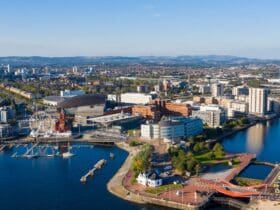Two big hitters in the creative industries have joined forces to champion a campaign for an £80 million investment zone to be set up in North East Wales.
Liam Evans-Ford, the executive director and chief executive of Theatr Clwyd in Mold and prolific Wrexham-born TV producer Ben Smith, who’s set up Tŷ’r Ddraig (Dragon House), in his home city, say it would “supercharge” the local economy.
The drive to create an Investment Zone in Wrexham and Flintshire is being spearheaded by a new consortium.
The group includes the North Wales Business Council, Wrexham and Flintshire councils, Wrexham University and the Advanced Manufacturing Research Centre in Broughton, and is chaired by Joanna Swash, Group CEO of Wrexham-based outsourced communications provider Moneypenny.
Investment Zones already exist in parts of England where £80 million in funding for each Zone will be used for innovation, infrastructure and skills and training projects in the sectors being targeted.
The group will be putting the case forward to the UK and Welsh governments for having an Investment Zone in North East Wales.
According to Liam Evans-Ford, the £45 million redevelopment of Theatr Clwyd is proof of the power of investment to boost the local economy.
When it’s fully re-opened in March 2025, Theatr Clwyd will be the first carbon positive theatre in the UK, possibly the world – and will have created 60 new jobs in the process of reinvigorating the flagship arts complex.
He said: “It will be a gas-free building with air source heat pumps, with solar panels and water harvesting as well as biodiversity.
“The footprint of the building is also being remodelled and we will be bringing all our making teams on site.
“We are one of only four theatres in the UK to have all our making departments in-house – scene construction with welders and carpenters, the costume and props makers as well as the lighting and sound teams.
“At the moment we have 140 core employees and over the next 18 months because of this investment there will be a minimum of another 60 jobs created.
“It tells you about the power of investment and a lot of those jobs have real career progression opportunities around them because they are quite specialist.
“So, having an investment zone in North Wales is a no-brainer as far as I’m concerned.
“It’s not just about attracting new investment into the area – important though that is – but it’s also about building on the qualities we have, whether it’s advanced manufacturing or creative and digital industries. These are all really exciting sectors.”
Meanwhile, Ben Smith, the creative director of Tŷ’r Ddraig, says his homecoming is particularly timely because of the new energy in Wrexham created by the takeover of the football club by Hollywood A-listers Rob McElhenney and Ryan Reynolds.
He’s established a track record for developing and producing successful high volume factual programmes and documentaries for the BBC, ITV, Sky, Channel 4 and Channel 5, as well as streaming services such as Netflix, Amazon Prime and Discovery.
Tŷ’r Ddraig has been backed financially with a significant investment by the Workerbee Group, which is part of Banijay UK.
Ben said: “We see North East Wales in particular as presenting an amazing opportunity for production companies making factual entertainment programmes.
“It feels under represented both onscreen and offscreen so there’s a creative reason for being here as well as a business opportunity.
“It’s a great opportunity for youngsters growing up in Wrexham now, and a big part of our plan is to train local people at entry level, working with Wrexham University who have a great broadcast course.
“The sort of shows that we see ourselves making create big teams because we plan to pitch for and make high volume factual series with 10, 20 or 30 episodes.
“Thanks to what’s been happening with the football club, Wrexham is now one of the most famous cities in the world and that was really helpful. When we were pitching our business plan to the group they already knew what kind of place Wrexham is.
“It would be brilliant if the creative industries, along with advanced manufacturing, could be at the forefront in securing an investment zone so we can build on the bigger recognition we’re getting as a result of the Hollywood stardust that’s been sprinkled on our belove football club and the wider area.”
Ashley Rogers, chief executive of the North Wales Business Council, added: “An investment zone can help with particular sectors which have international strengths but also local challenges. So the £80 million in funding could go towards improving infrastructure, transport to key employment sites, skills and training – whatever is needed by those sectors.
“We’ve seen what’s happening in England and we feel it would be an excellent opportunity for North East Wales and it would balance nicely with a Freeport on Anglesey.
“Substantial, focused investment into key sectors such as creative and digital or advanced manufacturing over a period of five years would turbocharge the development of those sectors and safeguard the jobs within them.
“We’re already punching above our weight, with what’s happening at Theatr Clwyd, which also runs William Aston Hall in Wrexham, along with what else is happening in the city, so there is no better time to invest in this area.
“We’d like to convince UK Government and Welsh Government that, if investment zones come to Wales, we have one in North East Wales and to work in partnership with them to co-develop it.
“For creative and digital in particular, if that was a sector that was included, funding could go towards helping to solve challenges around labour market size and access to low carbon sites and premises with good public transport and digital connectivity.”









Leave a Reply
View Comments